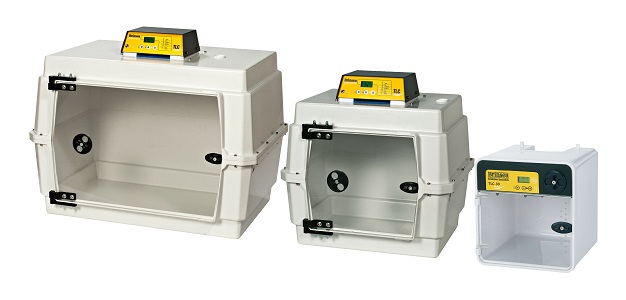
Neonatal Kittens and Incubators
Caring for neonatal kittens (kittens up to four weeks old) can be a difficult job, but success is so rewarding it makes the rest worth it. Kittens at this stage are very unstable, which means it is likely they will not all survive. So, the first thing to do when caring for neonatal kittens is to prepare yourself for possibly watching them fade, but hoping for the best. Below is more information on how to help these helpless kittens and the importance of using an incubator. Contact us today if you have any questions!
Critical First Steps for Neonatal Kittens
- Don't Do It Alone: If you are inexperienced, contact a local vet, no-kill shelter, or animal welfare network immediately for guidance.
- Provide Heat First: Kittens cannot regulate their body temperature. They must be warmed before you attempt to feed them. A chilled kitten is in danger.
- Use Proper Formula: Never give a kitten cow’s milk. Only use kitten-specific formula to avoid deadly dehydration from diarrhea.
-
Don’t Do it Alone
If you suddenly find yourself with one or more kittens on your hands and you aren’t an experienced rehabber, it’s always best to find some help. Here’s who you can contact:
- Your Local Vet: They can provide immediate medical advice and connect you with resources.
- No-Kill Shelters or Rescues: They may have experienced staff or a nursing mother cat who can take the kittens.
- Animal Welfare Networks Online: Groups on social media and forums can offer a wealth of experience and support.
Don’t be afraid to ask for help; it is a kitten’s best chance for survival!
-
The First Step: Heat
Baby mammals, especially kittens under three weeks old, have a hard time regulating their own body temperature. Providing a consistent source of warmth is the most critical first step.
How to Provide Warmth
- Use an Incubator or Heating Pad: Place kittens in a specialized incubator like our TLC units or on a heating pad set to low. Ensure there is always a cooler area they can move to if they get too warm.
- Watch for Chilling: A chilled kitten will be lethargic and cool to the touch. This is a sign of a medical emergency.
- Use Body Heat in an Emergency: If you don’t have a heat source like an incubator, you can use your own body heat by gently rubbing the cold kitten.
Critical "Don'ts" for Kitten Safety
- NEVER bottle feed a kitten until they are fully warmed up.
- NEVER bathe a neonatal kitten. A wet kitten is a cold kitten, which can be fatal. If cleaning is necessary, use a warm, moist towel and gently blow-dry them immediately after.
Why an Incubator is the Best Tool
Providing a warm, clean, and controlled environment is critical for the recovery of neonatal kittens. Their tiny bodies lose heat rapidly, making a professional incubator like Brinsea's TLC Intensive Care Units the gold standard. These units are trusted by veterinarians and rescue organizations to provide the consistent, gentle warmth needed for survival and give these vulnerable kittens the best possible chance of survival.
-
Second: Food
If you do not have a nursing mother available, the only safe food for kittens is kitten formula. TV shows and movies might lead you to believe that kittens will do just fine on cow’s milk, but this can cause diarrhea which leads to dehydration. In kittens this can be deadly.
Feeding Technique
-
Use the Right Equipment: Use kitten formula from a pet supply store or vet, and feed with a bottle designed specifically for this purpose.
-
Stay Clean: Always sterilize the bottle before using and wash your hands before and after handling the kittens.
-
Position Correctly: Hold or place the kitten on its stomach when feeding, never on its back. Arch the bottle so that less air gets in.
-
Warm the Formula: Always warm the formula (warm, not hot) before feeding the kitten.
As a reminder, do not feed kittens until they are warmed up properly.
Kittens usually stop eating when they are full. Tube feeding may be necessary if the kitten is too sick to bottle feed, and you should consult with a veterinarian before attempting this if you are inexperienced.
Feeding Schedule
Kitten's Age Feeding Frequency Up to 10 days old Every two hours, around the clock. 11 days to 2.5 weeks Every three to four hours. 2.5 to 4 weeks Every five to six hours. 4+ weeks Begin weaning with a wet food/formula mixture, two to three times a day. -
-
Third: After Feeding & Potty Training
Burping
Kittens need to be burped just like babies. Place them on your shoulder on their stomachs and pat gently until you feel a burp. You may need to clean the sticky formula off the kitten with a warm, damp cloth and blow-dry them.
Potty Training
-
Stimulate Young Kittens: Nursing mothers lick their kittens to stimulate urination and defecation. You must replicate this by gently rubbing the kitten’s anal area with a warm, moist cotton ball after feeding.
-
Introduce a Litter Box: At about four weeks, kittens can start litter training. Be sure to use a small, shallow pan with non-clumping litter to start.
While on formula, kittens will be unable to form solid feces, so they may need to be cleaned afterward. Using material other than litter (such as paper or fabric) can create bad habits in kittens, so stick with litter.
-
-
Common Health Problems
Being so small and vulnerable, kittens can spiral quickly, which means constant monitoring is essential. The best way to spot health problems early on is to weigh your kittens regularly.
Monitor Weight Closely
Weigh kittens twice a day at the same time and log the weight each time. Losing weight or not gaining weight can be a bad sign, so get in touch with your vet as quickly as possible if you notice this.
Specific Issues to Watch For
-
Upper Respiratory Infection (URI): Symptoms include heavy yellow discharge or trouble breathing/eating. A serious URI requires veterinary care, but a mild URI can be treated by cleaning the discharge and keeping kittens in a warm, damp place like an incubator with humidity control.
-
Fleas: Fleas on kittens can cause anemia. Use a flea comb to remove as many as possible. For a bad case, you may need to bathe the kitten in warm water with a small amount of liquid dish soap (avoid the eye area and rinse thoroughly). Do not use any kind of flea medication or flea shampoo on kittens younger than six weeks.
-
Parasites: Deworming treatment can start on kittens as young as 10 days old, so consult with your vet. Be on the lookout for any drastic change in stool consistency, as parasites can cause dangerous diarrhea.
-
-
A Story from Cat House on the Kings
Cat House on the Kings is a no-cage, no-kill sanctuary for feral and abandoned cats and kittens. We donated a TLC unit to them in the past to help with their work. Below is the response we got from Beth in public relations:
"We have many newborn kittens that come in during the summer “kitten flood” and they cannot regulate their own body temperature... Incubators and other forms of heat are important for the work we do because we don’t always receive newborn kittens with their mothers... it makes a huge difference having an incubator to help keep kittens at the right temperature, while Lynea attends to other kittens needs."
Not spayed mama and kittens
We had just rescued this adult female cat, who actually arrived with a certificate showing that she’d been spayed. A very short while later, she gave birth to a litter of 6 kittens! (Definitely an OOPS on someone’s part!) Mom and fluff balls are doing well, with help from staff and our incubator. Being an inexperienced mother, she needed help keeping her kittens warm.
The "Wee Kitten"
A wee kitten came in as part of a mama-less litter and she was the tiniest and took longer to thrive. She needed special additional treatment and had to be separated temporarily from her siblings. The incubator and keeping her warm were vital to her healing and growing. The incubator also helps provide individual care when needed, even if the kittens are a part of a litter.
-
How to Estimate a Kitten’s Age
Estimating a kitten’s age is important for feeding and weight tracking. Please note that the weights listed below are an estimate for the age ranges, not an exact number.
Age Range Characteristics & Est. Weight Newborn - one week Weight: 100-200g. Kittens will be unable to walk. Their eyes will be shut and their ears folded down. They can purr and make small noises, with a visible umbilical cord. One - two weeks Weight: 200-300g. Kittens will be able to move around a bit by crawling and cuddling. Their eyes and ears will start to open. Three weeks Weight: 400g. Kittens can stand and take short steps. Their eyes and ears will be fully open. Kittens will be responsive to interaction. Baby teeth will start to appear. Four - five weeks Weight: 500-600g. Kittens will be much more active with running, digging, and jumping. Kittens can begin to wean and use a litter box at this age. Eight weeks Weight: 900g. Kittens will start to look and act like mini versions of their adult counterparts.
Further Information
Caring for kittens is not something that should be undertaken lightly. Don’t hesitate to get in touch with Brinsea Products for more information on our TLC incubators. You can call our office at (888) 667-7009 or message us on Facebook or Instagram.


